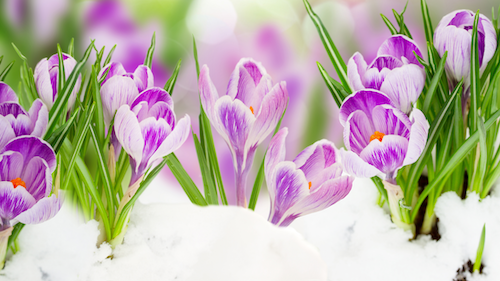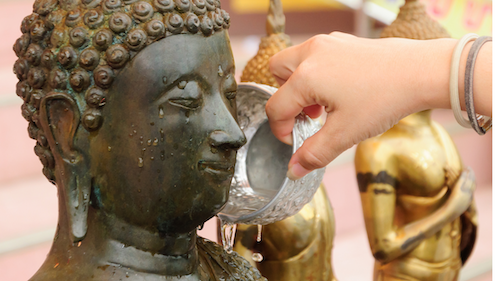
Spring is an important and wonderful time of year celebrated around the world in all sorts of fun ways! Let’s explore the different festivals that ring in spring!
Holi in India
Holi is a springtime celebration which dates back to the 4th century in India! It began as a Hindu festival. Lasting for a night and a day, it begins with the full moon on the evening of Purnima. That is on the Hindu calendar in the month of Phalguna.
For everyone using the Gregorian calendar, the holiday falls in the middle of March.
People light bonfires the first evening of Holi then gather around the fires and sing and dance. The fire represents the victory of good over evil.
The next day is the celebration of color… Lots of color!
People walk around with water guns loaded with colored water, and handfuls of colored powders. They throw the powders on each other and up into the air. They also soak one another with the colored water!
It’s definitely the most colorful festival around! And each color used represents something important.
Red symbolizes love.
Blue stands for determination.
Green I s all about life and happiness.
Yellow represents knowledge.
Hindu people around the world observe Holi, a wonderfully brilliant celebration.
.png)
Songkran in Thailand
Songkran is a celebration of the Thai New Year. Celebrated in mid-April, it’s a gathering of family, honoring traditions, and “washing away” the previous year to start the next one fresh.
The holiday is traditionally celebrated by visiting family and pouring water over Buddha statues. This symbolizes washing away the previous year’s bad luck.
People visit the Buddhist temples and bring offerings for the monks in residence. They take food and robes. They also bring sand. Why sand? It’s to replenish the sand which was taken away throughout the year on people’s shoes!
Once the traditional observances are done, it’s time to hit the streets for a good soaking!
The major streets are blocked off for the event. Everyone grabs something that will hold water… water guns, buckets, anything they can find. Businesses take part, too. They bring out the hoses and spray people going by!
It turns into the wildest water-fight in the world!

Las Fallas de Valencia
This celebration takes place in Valencia, Spain and is quite the spectacle! The origin of the word falla means… torch. Yep. The festival is all about big bon fires.
The origin of Las Fallas isn’t really clear. One legend says that it was started centuries ago by carpenters. These woodworking people would burn the scraps of wood and the bits they’d used during the winter to support their oil lamps.
The clean-up took place the day before St Joseph’s day, right around the time of the spring equinox. St. Joseph was the patron saint of carpenters in the Catholic religion.
Since the longer days after the equinox meant the carpenters had to work longer, they burned the wood to conserve the oil in their lamps to light their work.
They also began to add bits and pieces of anything unwanted which had been lying around their homes. The bon fires turned into a bit of competition. People began to see who could build the biggest fire.
Another legend surrounding the festivities says the tradition goes back much further. Bon fires were lit on the equinoxes to celebrate the changing seasons.
At least one thing is certain, this festival has been around since the second half of the 18th century. The Valencian government set laws about where the fires could be set!
Whether it was carpenters getting rid of stuff, or people gathering to celebrate the changing seasons, the celebration has evolved into a huge sight to see!
The entire festival of Las Fallas lasts 5 days, from March 15-19. Fireworks displays, live music, parades, and foods are all part of the celebration.
The main attraction of Las Fallas are huge statues, made of cardboard, paper mâché, wood, or plaster. Some of these figures are several stories tall! They need cranes to move them into their places in the parks, plazas, and on the streets.
Everyone wanders through all the statues and then a vote is cast for the favorite. The favorite ends up in the Las Fallas museum.
What happens to the rest of the statues?
On the last day of Las Fallas, all the creative works of art are set ablaze. When the sun sets on March 19th, the statues go up in flames.
The Boogg Festival of Switzerland
In Zurich, Switzerland, there is a festival which goes back to 1902. Celebrating the end of winter, a tall pyre is built and a snowman effigy is placed on top. And effigy is a model of a person, or in this case, a representation of all the snow from the long Swiss winter.
One more thing: the snowman’s head is filled with fireworks.
On the day of the festival, the people hold a craft guild parade. This parade is for the people in craft-trades such as bakers, woodworkers, and metalsmiths.
Initially, the Boogg festival was a tradition to signify the coming of spring and longer daylight hours. The pyre was set ablaze to “burn winter away.”
Now it has become a predictor of what the summer will be like. Kind of like the traditions around groundhog day!
The pyre is lit and it’s timed… to see how long it takes for the firework-filled snowman’s head to explode!
If it happens fast, it means a good, warm summer. If it takes a long time, it means a cold, wet summer. And this weird weather prediction method has about the same accuracy as Punxsutawney Phil seeing his shadow.
What is your favorite way of welcoming spring? You can include some fun spring foods as you eat2explore!
 Rowena Scherer is a French Culinary Institute-trained home chef who knows what kids love to eat and how food and culture are intertwined. When she discovered that her own kids (who loved travel and world cuisines) couldn't even chop an onion, she was momentarily crushed. She'd grown up in Malaysia, and some of her fondest memories were of cooking together there, as a family, learning and telling stories.
Rowena Scherer is a French Culinary Institute-trained home chef who knows what kids love to eat and how food and culture are intertwined. When she discovered that her own kids (who loved travel and world cuisines) couldn't even chop an onion, she was momentarily crushed. She'd grown up in Malaysia, and some of her fondest memories were of cooking together there, as a family, learning and telling stories. Now she designs cooking kits to recreate that experience, and broaden it, using the unique foodways of various cultures as a bridge into fun learning and great eating for curious kids and their adults.eat2explore office: 646-207-727





